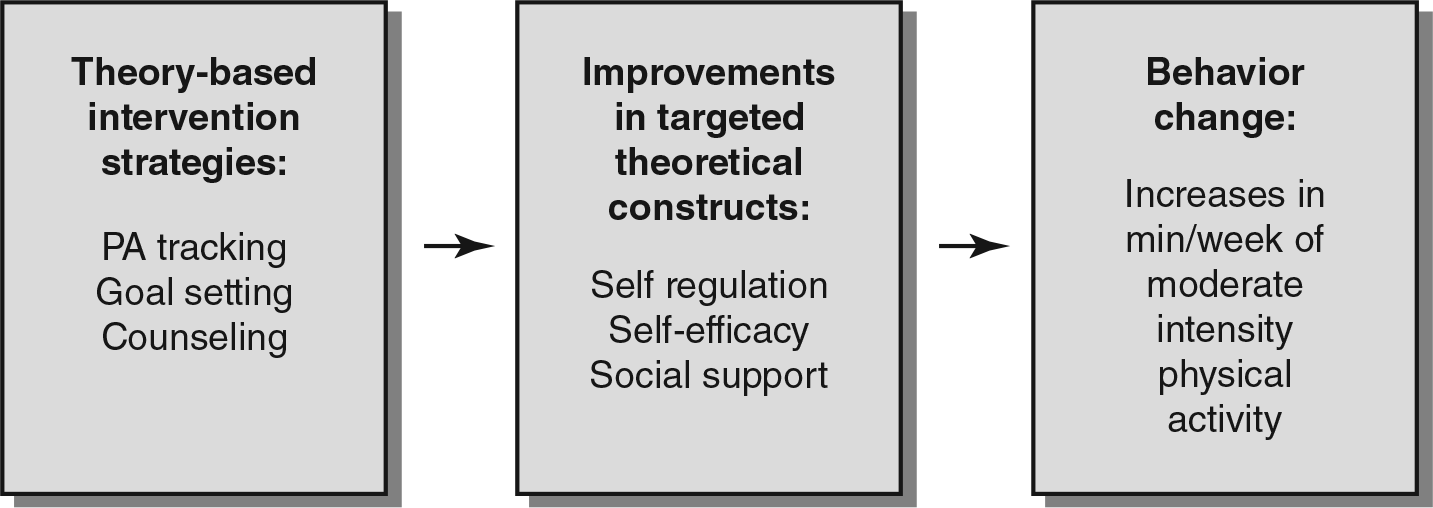Consider Mediators of Physical Activity Behavior Change
This is an excerpt from Motivating People to Be Physically Active-3rd Edition by Bess H Marcus,Dori Pekmezi.
When assessing the effectiveness of your interventions, you should consider not only measures of physical activity behavior but also changes in relevant psychological and behavioral mediators of physical activity behavior change. By paying attention to the parts of your program that were effective in helping your clients move toward a physically active lifestyle, you can learn what strategies work best for changing physical activity behaviors and get ideas for improving future programs (Baranowski et al., 1998; Bauman et al., 2002; Larsen et al., 2021; Linke et al., 2014). In other words, is your intervention successful for the reasons suggested by the theory you used to design it? For instance, if encouraging your client to track physical activity and set goals appears to be partly responsible for your client’s increases in physical activity, then you probably will want to incorporate those strategies into a program you design for someone else.
Assessing psychosocial constructs related to change becomes especially important as we work to discover what helps unmotivated people move toward considering a more active lifestyle. For people in stage 1 (not thinking about change) or stage 2 (thinking about change), it is probably unrealistic to expect them to increase their actual activity to meet the national physical activity guidelines. Instead, a more realistic goal for these clients would be to promote change in factors that could lead to more physical activity down the road (e.g., identifying the pros of physical activity, enhanced self-efficacy). Helping less motivated people even start thinking about how their health and outlook might improve if they were to be more active should be considered a successful outcome. Therefore, learning what needs to happen within people for change to occur (i.e., discovering the mediators) is well worth your time and effort, as illustrated by the example Examining Mediators.
Learning How It Works
Examining Mediators
This case example demonstrates the usefulness of looking at change in the theoretical constructs used to design a physical activity intervention. In this study, sedentary but healthy Latina women received Spanish-language printed materials on physical activity or other wellness topics (Marcus et al., 2013). The physical activity program was theoretically based and used constructs derived from social cognitive theory and the transtheoretical model. In this program participants received motivationally tailored manuals along with individualized feedback reports on their progress in self-reported physical activity, stage of motivational readiness, self-efficacy, and cognitive and behavioral processes of change. (The Seamos Saludables study is described in more detail in chapter 5.) The feedback reports were about four pages and provided each participant with information regarding any personal improvements or declines in these areas and their standing in comparison with others who had become active. These materials were sent via mail over six months, with four mailings in month one, two in months two to three, and one in months four to six.
The participants in the physical activity program reported significantly greater increases in physical activity compared to those who received the wellness materials at six months. The investigators were interested in looking at possible changes in the theoretical constructs used in the individually tailored intervention to learn what aspects of the intervention made it more effective than the wellness program. What they found was that participants who had received the individually tailored intervention had greater increases in social support for physical activity compared to the wellness control group from baseline to after treatment, and these increases in social support were responsible for the improvements in physical activity (Marquez et al., 2016).
Moreover, results indicated that different types of support may be important at varying time points. For example, help from family may get you started with physical activity, but supportive friends play more of a role in continuing these healthy habits. This analysis of possible mediating constructs can be used to develop more effective strategies in future programs.
The theoretical model that serves as the basis for a program suggests which factors might be responsible for producing change in physical activity behavior. For example, a program based on social cognitive theory may focus on improving self-efficacy and outcome expectations for physical activity because changes in these factors are thought to lead, in turn, to more physical activity. When you hypothesize about possible mediators of your program’s success, keep in mind that several mediators may be working at once (Baranowski et al., 1998; Koring et al., 2012; Napolitano et al., 2008). For example, self-efficacy, outcome expectations, and the use of several behavior change processes may mediate the results of your intervention. Therefore, it is wise to consider and measure several possible mediators. Combining theories (e.g., the transtheoretical model and social cognitive theory) and building a program around several possible mediators (e.g., self-efficacy, enjoyment) are likely to make the program more successful, as shown in figure 4.1.

SHOP

Get the latest insights with regular newsletters, plus periodic product information and special insider offers.
JOIN NOW
Latest Posts
- Using double inclinometers to assess cervical flexion
- Trunk flexion manual muscle testing
- Using a goniometer to assess shoulder horizontal adduction
- Assessing shoulder flexion with manual muscle testing
- Sample mental health lesson plan of a skills-based approach
- Sample assessment worksheet for the skill of accessing valid and reliable resources


